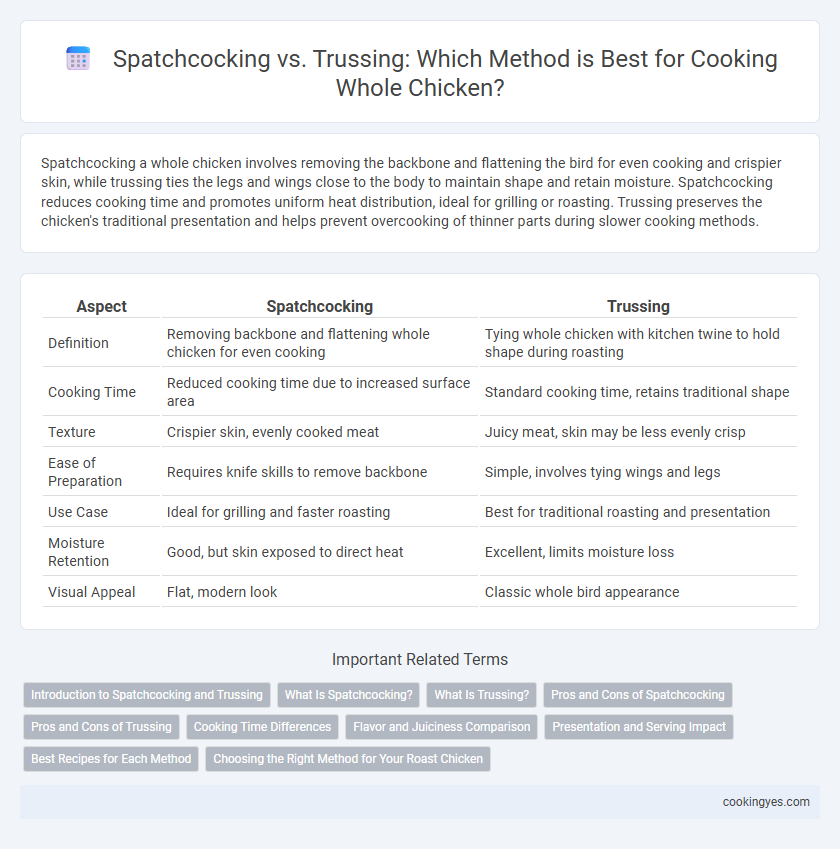Spatchcocking a whole chicken involves removing the backbone and flattening the bird for even cooking and crispier skin, while trussing ties the legs and wings close to the body to maintain shape and retain moisture. Spatchcocking reduces cooking time and promotes uniform heat distribution, ideal for grilling or roasting. Trussing preserves the chicken's traditional presentation and helps prevent overcooking of thinner parts during slower cooking methods.
Table of Comparison
| Aspect | Spatchcocking | Trussing |
|---|---|---|
| Definition | Removing backbone and flattening whole chicken for even cooking | Tying whole chicken with kitchen twine to hold shape during roasting |
| Cooking Time | Reduced cooking time due to increased surface area | Standard cooking time, retains traditional shape |
| Texture | Crispier skin, evenly cooked meat | Juicy meat, skin may be less evenly crisp |
| Ease of Preparation | Requires knife skills to remove backbone | Simple, involves tying wings and legs |
| Use Case | Ideal for grilling and faster roasting | Best for traditional roasting and presentation |
| Moisture Retention | Good, but skin exposed to direct heat | Excellent, limits moisture loss |
| Visual Appeal | Flat, modern look | Classic whole bird appearance |
Introduction to Spatchcocking and Trussing
Spatchcocking a whole chicken involves removing the backbone and flattening the bird for even cooking and crispy skin, which reduces cooking time significantly. Trussing, on the other hand, means tying the legs and wings close to the body to ensure uniform shape and moisture retention during roasting. Both techniques enhance cooking efficiency and texture but serve different purposes depending on the desired outcome.
What Is Spatchcocking?
Spatchcocking is a technique where the backbone of a whole chicken is removed and the bird is flattened before cooking, which allows for more even heat distribution and faster cooking times compared to traditional methods. This method enhances the skin crispiness and ensures the meat cooks uniformly, reducing the risk of overcooked or undercooked sections. Unlike trussing, which ties the chicken to maintain shape, spatchcocking spreads the chicken out, optimizing surface area for grilling, roasting, or smoking.
What Is Trussing?
Trussing a whole chicken involves tying the legs and wings tightly against the body using kitchen twine to ensure even cooking and maintain a compact shape. This method helps prevent the extremities from drying out while keeping stuffing securely inside the cavity. Unlike spatchcocking, which removes the backbone to flatten the bird, trussing maintains the chicken's traditional form for roasting.
Pros and Cons of Spatchcocking
Spatchcocking a whole chicken involves removing the backbone and flattening the bird, which promotes even cooking and reduces overall roasting time by up to 25%. This technique enhances skin crispiness and allows for more consistent heat distribution but can be challenging to execute correctly without prior experience. However, spatchcocked chickens may lose juices more quickly, resulting in slightly less moist meat compared to trussed chickens, which retain shape and moisture better during roasting.
Pros and Cons of Trussing
Trussing a whole chicken helps ensure even cooking by keeping the bird compact, which allows heat to circulate more uniformly and prevents the wings and legs from drying out or burning. However, trussing can slow the skin's exposure to heat, potentially reducing crispiness compared to spatchcocking, where the chicken is flattened for faster, more even roasting. While trussing preserves a traditional shape for presentation and stuffing, it may require more skill and time, making it less convenient than the quicker spatchcock method.
Cooking Time Differences
Spatchcocking a whole chicken significantly reduces cooking time by flattening the bird and increasing its surface area, allowing heat to penetrate more evenly and quickly compared to trussing. Trussing keeps the chicken compact, which can result in longer roasting times due to restricted airflow and uneven heat distribution around the thicker sections. Choosing spatchcocking over trussing can cut cooking time by up to 25-30%, enhancing the efficiency of heat transfer and achieving a crispier skin overall.
Flavor and Juiciness Comparison
Spatchcocking a whole chicken enhances flavor and juiciness by allowing heat to penetrate evenly and skin to crisp thoroughly, resulting in a more succulent outcome. Trussing, while improving presentation and aiding even cooking, can trap steam that slightly diminishes skin crispness and flavor intensity. Opting for spatchcocking maximizes browning and moisture retention, creating a juicy, flavorful chicken with rich texture contrasts.
Presentation and Serving Impact
Spatchcocking a whole chicken ensures even cooking and creates a flat, crispy presentation that makes carving and serving easier at the table. Trussing maintains the bird's compact shape, resulting in a more traditional, vertical roast appearance that can enhance visual appeal when served whole. Choosing spatchcocking improves portioning efficiency, while trussing emphasizes a classic presentation ideal for elegant plating.
Best Recipes for Each Method
Spatchcocking a whole chicken involves removing the backbone and flattening the bird, which promotes even cooking and crispy skin, making it ideal for recipes like smoked barbeque chicken or roasted herb chicken. Trussing, tying the legs and wings close to the body, preserves the chicken's shape and moisture, complementing slow-roasted or stuffed chicken recipes such as classic roast chicken with garlic and thyme. The choice between spatchcocking and trussing depends on desired cooking time and texture, with spatchcocking providing quicker, crispier results and trussing ensuring juicier, evenly cooked meat.
Choosing the Right Method for Your Roast Chicken
Spatchcocking a whole chicken involves removing the backbone and flattening the bird, which promotes faster, more even cooking and crispier skin, ideal for roasting or grilling. Trussing, which ties the legs and wings close to the body, helps the chicken maintain its shape and retain moisture, resulting in a juicier roast with uniform cooking. Choosing between spatchcocking and trussing depends on your preference for cooking time, skin texture, and presentation style of your roast chicken.
Spatchcocking vs Trussing for Whole Chicken Infographic

 cookingyes.com
cookingyes.com